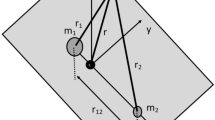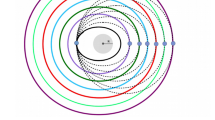Abstract
Due to the limits of size and weight of probes, analysis and design of the low-energy escaping orbit play a significant role in saving the energy in space exploration. In this paper, we research the mechanism of the evolution of the probe orbital energy and develop a design method for the low-energy escaping orbits in the Earth–Moon system. A dynamic model accounting for the Sun–Earth–Moon-probe elliptical four-body problem is presented by considering Moon’s eccentricity and Sun’s direct gravitational influence. Considering the influences from phase of Earth, Moon and Sun, the equations of the probe orbital energy and its variation are derived and theoretical analysis is implemented based on corresponding energy expressions. Then, the Poincaré mapping technique is utilized to search two types of low-energy families of escaping orbits and the results of numerical simulation confirm the theoretical predictions. The dynamic model proposed in this paper is more accurate and has practical value comparing with the circular restricted three-body problem, and the escaping strategy can save over 25 % of energy relative to the hyperbolic escaping.















Similar content being viewed by others
References
Landau, D., Strange, N.: Near-earth asteroids accessible to human exploration with high-power electric propulsion. Adv. Astronaut. Sci. 142, 635–654 (2012)
Crawford, I.A., Anand, M., Cockell, C.S., Falcke, H., Green, D.A., Jaumann, R., Wieczorek, M.A.: Back to the Moon: the scientific rationale for resuming lunar surface exploration. Planet. Space Sci. 74(1), 3–14 (2012). doi:10.1016/j.pss.2012.06.002
Pavlak, T.A., Howell, K.C.: Evolution of the out-of-plane amplitude for quasi-periodic trajectories in the Earth–Moon system. Acta Astronaut. 81(2), 456–465 (2012). doi:10.1016/j.actaastro.2012.07.025
Ivashkin, V.V.: On particle’s trajectories of moon-to-earth space flights with the gravitational escape from the lunar attraction. Dokl. Phys. 49(9), 539–542 (2004). doi:10.1134/1.1810582
Parker, J.S., Anderson, R.L.: Targeting low-energy transfers to low lunar orbit. Acta Astronaut. 84, 1–14 (2013). doi:10.1016/j.actaastro.2012.10.033
Robinson, M.S., Plescia, J.B., Jolliff, B.L., Lawrence, S.J.: Soviet lunar sample return missions: landing site identification and geologic context. Planet. Space Sci. 69(1), 76–88 (2012). doi:10.1016/j.pss.2012.03.013
Haase, I., Oberst, J., Scholten, F., Wahlisch, M., Glaser, P., Karachevtseva, I., Robinson, M.S.: Mapping the Apollo 17 landing site area based on lunar reconnaissance orbiter camera images and Apollo surface photography. J. Geophys. Res. Planet. 117 (2012). doi:10.1029/2011je003908
Belbruno, E.A., Miller, J.K.: Sun-perturbed Earth-to-Moon transfers with ballistic capture. J. Guid. Control Dyn. 16(4), 770–775 (1993). doi:10.2514/3.21079
Belbruno, E., Gidea, M., Topputo, F.: WEAK STABILITY BOUNDARY AND INVARIANT MANIFOLDS. SIAM J. Appl. Dyn. Syst. 9(3), 1061–1089 (2010). doi:10.1137/090780638
Uesugi, K.: Results of the MUSES-A “HITEN” mission. Missions Moon Explor. Cold Universe 18(11), 69–72 (1996). doi:10.1016/0273-1177(96)00090-7
Circi, C.: Lunar base for Mars missions. J. Guid. Control Dyn. 28(2), 372–374 (2005). doi:10.2514/1.12218
Ivashkin, V.V.: Low energy trajectories for the Moon-to-Earth space flight. J. Earth Syst. Sci. 114(6), 613–618 (2005). doi:10.1007/Bf02715945
Lo, M.W.: The InterPlanetary Superhighway and the origins program. In: 2002 IEEE Aerospace Conference Proceedings, vols. 1–7, pp. 3543–3562 (2002)
Finocchietti, C., Pergola, P., Andrenucci, M.: Venus transfer design by combining invariant manifolds and low-thrust arcs. Acta Astronaut. 94(1), 351–362 (2014). doi:10.1016/j.actaastro.2013.03.013
Ren, Y., Shan, J.J.: Low-energy lunar transfers using spatial transit orbits. Commun. Nonlinear Sci. 19(3), 554–569 (2014). doi:10.1016/j.cnsns.2013.07.020
Anderson, R.L., Parker, J.S.: Comparison of low-energy lunar transfer trajectories to invariant manifolds. Celest. Mech. Dyn. Astronomy 115(3), 311–331 (2013). doi:10.1007/s10569-012-9466-3
Howell, K.C., Davis, D.C., Haapala, A.F.: Application of periapse maps for the design of trajectories near the smaller primary in multi-body regimes. Math Probl Eng (2012). doi:10.1155/2012/351759
Villac, B.F., Scheeres, D.J.: Escaping trajectories in the Hill three-body problem and applications. J. Guid. Control Dyn. 26(2), 224–232 (2003). doi:10.2514/2.5062
Koon, W.S., Lo, M.W., Marsden, J.E., Ross, S.D.: Low energy transfer to the Moon. Celest. Mech. Dyn. Astronomy 81(1–2), 63–73 (2001). doi:10.1023/A:1013359120468
Gomez, G., Koon, W.S., Lo, W.S., Marsden, J.E., Masdemont, J., Ross, S.D.: Connecting orbits and invariant manifolds in the spatial restricted three-body problem. Nonlinearity 17(5), 1571–1606 (2004). doi:10.1088/0951-7715/17/5/02
He, W., Xu, S.J.: Study on escaping energy in circular restricted three-body problem. Acta Aeronaut. Astronaut. Sin. 28(2), 263–268 (2007)
Kolemen, E., Kasdin, N.J., Gurfil, P.: Multiple Poincar, sections method for finding the quasiperiodic orbits of the restricted three body problem. Celest. Mech. Dyn. Astronomy 112(1), 47–74 (2012). doi:10.1007/s10569-011-9383-x
Paskowitz, M.E., Scheeres, D.J.: Robust capture and transfer trajectories for planetary satellite orbiters. J. Guid. Control Dyn. 29(2), 342–353 (2006). doi:10.2514/1.13761
Davis, D.C., Howell, K.C.: Long-term evolution of trajectories near the smaller primary in the restricted problem. Spacefl. Mech. Pts I–III 136, 1277–1296 (2010)
Haapala, A.F., Howell, K.C.: Trajectory design strategies applied to temporary comet capture including Poincar, maps and invariant manifolds. Celest. Mech. Dyn. Astronomy 116(3), 299–323 (2013). doi:10.1007/s10569-013-9490-y
Mingotti, G., Topputo, F., Bernelli-Zazzera, F.: Efficient invariant-manifold, low-thrust planar trajectories to the Moon. Commun. Nonlinear Sci. 17(2), 817–831 (2012). doi:10.1016/j.cnsns.2011.06.033
Kakoi, M., Howell, K.C., Folta, D.: Access to Mars from Earth–Moon libration point orbits: manifold and direct options. Acta Astronaut. 102, 269–286 (2014). doi:10.1016/j.actaastro.2014.06.010
Wang, S., Shang, H.B., Wu, W.R.: Interplanetary transfers employing invariant manifolds and gravity assist between periodic orbits. Sci. China Technol. Sci. 56(3), 786–794 (2013). doi:10.1007/s11431-013-5133-5
Mingotti, G., Topputo, F., Bernelli-Zazzera, F.: Earth-Mars transfers with ballistic escape and low-thrust capture. Celest. Mech. Dyn. Astronomy 110(2), 169–188 (2011). doi:10.1007/s10569-011-9343-5
Zhang, J.R., Zhao, S.G., Yang, Y.Z.: Characteristic analysis for elliptical orbit hovering based on relative dynamics. IEEE Trans. Aerosp. Electron. Syst. 49(4), 2742–2750 (2013)
Prado, A.F.B.D.: Close-approach trajectories in the elliptic restricted problem. J. Guid. Control Dyn. 20(4), 797–802 (1997). doi:10.2514/2.4115
Romagnoli, D., Circi, C.: Earth–Moon weak stability boundaries in the restricted three and four body problem. Celest. Mech. Dyn. Astronomy 103(1), 79–103 (2009). doi:10.1007/s10569-008-9169-y
Pourtakdoust, S.H., Sayanjali, M.: Fourth body gravitation effect on the resonance orbit characteristics of the restricted three-body problem. Nonlinear Dyn. 76(2), 955–972 (2014). doi:10.1007/s11071-013-1180-5
Qian, Y.J., Xiao, Y.Y., Jing, W.X., Gao, C.S.: Quasi-periodic orbit design about the Earth–Moon libration point. J. Aeronaut. Astronaut. Aviat. Ser. A 45, 11 (2013)
Peng, H.J., Chen, B.S., Wu, Z.G.: Multi-objective transfer to libration-point orbits via the mixed low-thrust and invariant-manifold approach. Nonlinear Dyn. 77(1–2), 321–338 (2014). doi:10.1007/s11071-014-1296-2
Qian, Y.J., Hwang, I.S., Jing, W.X., Wei, J.: New dynamic model for lunar probe and its application to quasi-periodic orbit about the translunar libration point. Adv. Astronaut. Sci. 142, 753–770 (2012)
Qian, Y.J., Li, C.Y., Jing, W.X., Hwang, I., Wei, J.: Sun–Earth–Moon autonomous orbit determination for quasi-periodic orbit about the translunar libration point and its observability analysis. Aerosp. Sci. Technol. 28(1), 289–296 (2013). doi:10.1016/j.ast.2012.11.009
Peng, H.J., Jiang, X., Chen, B.S.: Optimal nonlinear feedback control of spacecraft rendezvous with finite low thrust between libration orbits. Nonlinear Dyn. 76(2), 1611–1632 (2014). doi:10.1007/s11071-013-1233-9
Koon, W.S., Lo, M.W., Marsden, J.E., Ross, S.D.: Dynamical system, the three-body problem and space mission design. Elsevier, Amsterdam (2011)
Acknowledgments
The authors gratefully acknowledge the support of the National Natural Science Foundation of China (NNSFC) through grant Nos. 11402007, 11290150, 11290152, 11290154 and 11322214. the Funding Project for Academic Human Resources Development in Institutions of Higher Learning under the Jurisdiction of Beijing Municipality (PHRIHLB). Additional support is also appreciated through China Postdoctoral Science Foundation (Grant No. 2014M550576) and Beijing Postdoctoral Research Foundation (Grant No. 2014ZZ-25).
Author information
Authors and Affiliations
Corresponding author
Rights and permissions
About this article
Cite this article
Qian, Y.J., Zhang, W., Yang, X.D. et al. Energy analysis and trajectory design for low-energy escaping orbit in Earth–Moon system. Nonlinear Dyn 85, 463–478 (2016). https://doi.org/10.1007/s11071-016-2699-z
Received:
Accepted:
Published:
Issue Date:
DOI: https://doi.org/10.1007/s11071-016-2699-z




